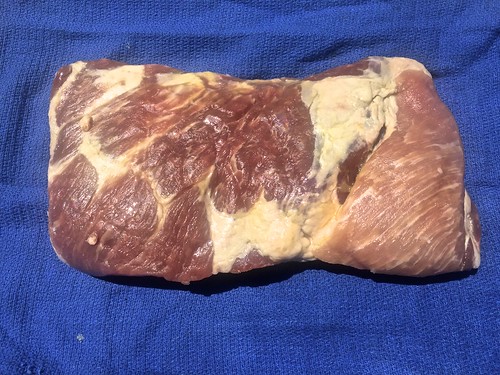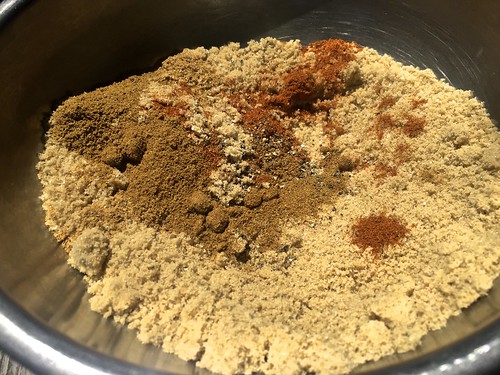But, now, the hot weather finally embraced the Pacific Palisades where we live. But, now worries, with temperatures reaching into the high-80s, it's time to cook up two favorite summertime recipes.
Low-temperature roasted pork ribs and watermelon gazpacho.
Dry Rub Pork Ribs, Cook Over-Night
Dry rub pork ribs that we cook overnight in a low-temperature oven. We wake up in the morning to the beautiful aroma of pork cracklings. All the cooking happens during the night when we're asleep.
Easy-to-make dry rub pork ribs take only a few steps to prepare and a good night's sleep: 1) clean the ribs, 2) layer on dry rub, 3) put into a 250 F oven when you go to bed and 4) wake up, remove the ribs and enjoy!
Cooking with high heat is exciting. There is great pleasure in watching the pyrotechnics of an outdoor grill as sizzling fat catches fire. Roasting at low heat in the oven lacks that excitement.
And yet, what happens in an oven set at 250 F has its own kind of magic. In the darkness of the oven, the waves of steady heat melt the fat inside the rack, tenderizing the meat and gently fusing the dry rub to the outside of the ribs.
The best magic of all is that the oven does the work. No standing over a blazingly hot grill on a hot day. Once the oven door closes, there is nothing to be done.
Walk into the kitchen and a savory-sweet aroma scents the air. Pull the baking tray out of the oven and press a finger against the outside of the rack. The soft pliancy of the meat has been replaced by a jerky-like crust as sweet as a crème brulee topping.
Slow-Roasted, Dry-Rubbed Pork Ribs

Rack of pork ribs, trimmed. Credit: Copyright 2016 David Latt
Cooking time depends on the size and thickness of the rack.
Buy good quality pork. Asian and Latin markets are often a reliable source of fresh pork products. Unlike the ribs sold in upscale supermarkets, the ribs in these markets will most likely be untrimmed.
Above the actual ribs, the rack will have a top portion with boneless flap meat and a section with thick bones similar to country style ribs. Another smaller piece of flap meat will stretch across the back of the rib bones.
Requiring only a sharp filleting knife and a few minutes, removing the flap meat and the top portion is not difficult. The flap meat is excellent to use in stir fries, slow roasted in the oven or grilled on the BBQ.
A white membrane is attached to the outside of the flap meat. Use a sharp filleting knife to separate the meat from the membrane and discard.
The flap meat and country style bones can be prepared in the same manner as the ribs. They will cook more quickly and should be removed from the 250 F oven after a total of 2 to 3 hours depending on thickness.
While the rack of ribs does not have to be turned over, the flap meat and country style bones should be turned over after one hour for even cooking. After another hour, use kitchen shears to cut off a small piece of meat to test for doneness. Return to the oven if the meat is not yet tender.
To eat the country style ribs, have a sharp paring knife handy to help cut out those hard to reach tasty bits tucked between the bones.
The ribs can be cooked ahead and reheated. In which case, do not cut apart the ribs until ready to serve. Reheat in a 300 F oven for 15 minutes.
Prep time: 30 minutes
Cooking time: 6 to 8 hours
Resting time: 5 minutes
Total time: 6 hours, 35 minutes to 8 hours, 35 minutes
Yield: 4 servings
Ingredients
1 rack pork ribs, 4 to 5 pounds, washed, dried
3 cups brown sugar
2 tablespoons kosher salt
2 tablespoons freshly ground black pepper
¼ cup cumin
¼ cup coriander
½ teaspoon cayenne (optional)
Directions
1. Place a wire rack in the middle of the oven. Preheat to 250 F.
2. Select a baking pan or cookie sheet that is 2 inches longer than the rack of ribs. Cover the pan with aluminum foil for easy clean up. Place a wire rack on top of the aluminum foil.
3. Lay the rack of ribs on a cutting board, bone side up. Use a sharp filleting knife to remove the tough membrane on the bone side of the rack. Let the knife help you lift the membrane. Use your fingers to pull the skin off the bones and discard.
4. Do not cut off any fat.
5. In a bowl, mix together dry ingredients.
6. For easy cleanup, lay a sheet of plastic wrap on the cutting board. Place the rack on the cutting board. Layer a thick coat of the dry spices onto both sides, covering the meat and bones.
7. Reserve left-over dry rub in an air tight container and refrigerate for later use.
8. Carefully place the rack of ribs on the wire rack meat side up.
9. Put the baking sheet into the preheated oven.
10. Roast six hours. Remove from oven. Use kitchen shears to cut off a small piece and taste.
11. The outside should have a jerky-crispness. The meat inside should be moist and tender. The tapered end of the rack where the bones are small will cook faster than the rest of the ribs. Use the kitchen shears to cut off that section before returning the rack to the oven for another one-two hours. Be careful not to dry out the meat.
12. Once the ribs are cooked, remove from oven and let the meat rest five minutes.
13. Cut between the rib bones and chop into pieces any flap meat without bones. Serve hot with a green salad, Cole slaw, baked beans or freshly steamed vegetables.
Gazpacho Takes on a Sweet Partner
My second favorite is a riff on gazpacho. We use a mix of watermelon and tomato juice to add lightness and sweetness and create a perfect summer afternoon cocktail.
I learned to appreciate this hybrid-gazpacho on a trip to Switzerland. In Zurich I had a tasting at Rive Gauche, the casual dining cafe at the historic and beautiful Baur au Lac Hotel close to Lake Zurich.
I stayed at the hotel to write a profile for Luxury Travel Magazine. I was eating at Rive Gauche because I was going to do a video cooking demonstration with the chef, Olivier Rais, a delightful, talented chef who is passionate about cooking.
One of the dishes he wanted me to enjoy was his version of gazpacho, one that added watermelon juice to soften the acidity of the ripe uncooked tomato juice that is the basis of traditional gazpacho. I have certainly seen this hybrid dish before.
But I was particularly taken with chef Rais' version, a clarified liquid served in a glass. All the vegetable bits had been strained out with the result that the gazpacho became an exceptionally refreshing, summer beverage.
When I interviewed chef Rais, he had recently returned from Los Angeles where he spent time at Crossroads Kitchen, a well-regarded vegan restaurant, owned by Tal Ronnen.
Invited to a tasting dinner at Crossroads Kitchen, I had an opportunity to enjoy chef Ronnen's version of the watermelon gazpacho. Similar in flavors but different, chef Ronnen did not filter out the vegetable bits, giving his gazpacho a deliciously rustic taste.
For my version, I split the difference between the two chefs. I strained the tomato pulp but retained some of the texture.
I hope you have the opportunity to visit Rive Gauche in Zurich and Crossroads Kitchen in Los Angeles to taste and compare their gazpachos. In the meantime, please try this very easy-to-make recipe.
Watermelon Gazpacho
Ripe tomatoes and a ripe watermelon are essential. Both should be sweet and full of juice.
If any watermelon juice is left over, make watermelon ice by gently heating the juice and reducing the liquid by a quarter. Cool, then pour into ice cube trays or a freezer-proof container. Freeze and use to sweeten vodka cocktails or lemonade. As the ice cubes melt, sweet watermelon juice releases into the drink. Delicious!
Serves 4-6
Total time to prepare: 20 minutes
Ingredients
2 pounds ripe tomatoes, washed, stems removed
2 pounds ripe watermelon, washed
1 ripe avocado
1 cup homemade croutons
1 ripe avocado, washed
5 dried bay leaves
1/4 teaspoon black peppercorns
1/4 teaspoon dried oregano
1/4 teaspoon dried thyme
Pinch cayenne
Sea salt to taste
Directions
Place a box grater over a non-reactive bowl. Grate the tomatoes and collect all the juice. Or, run the chopped tomatoes through a food mill and collect the juice. Scrape the pulp off the underside of the food mill sieve and add to the juice. Pour into a large container.
Add the dried spices to the tomato juice. Cover and refrigerate at least one hour or overnight.
Use a sharp knife to cut off the watermelon rind. Press the flesh through a fine mesh sieve or through a food mill and collect all the juice. Pour into a large container and refrigerate.
Just before serving, peel the avocado, remove the pit and chop into dime-sized pieces. Pour the tomato juice through a sieve to remove the dried spices.
Combine equal amounts of seasoned tomato juice and watermelon juice and mix well.
Pour gazpacho into bowls or cups. Top with avocado and croutons. Serve chilled.
















